Herons are large, striking birds from the Ardeidae family that contains some 64 species. Herons, bitterns and egrets belong to the same family and are all wading birds with long legs, necks and bills.
Herons are primarily carnivorous and have a fierce reputation for hunting fish - they’re a menace to fish ponds up and down the UK.
Herons are highly intelligent and are among a handful of birds that use tools to catch their prey. Some herons also engage in an unusual hunting technique called “canopy fishing”, where the heron sits in a river or lake and forms an enclosed canopy with its wings to attract fish.
Some herons, such as the Goliath heron, are exceptionally large birds that stand up to 1.5m tall - some of the tallest birds in the world. Other species, such as the diminutive Little bittern, are much smaller.
The UK is home to three regular breeding species of herons and around seven species that arrive as vagrants from other parts of the world.
Common Heron Species in the UK
The following British herons are more common and are found throughout the UK.
Grey Heron
Ardea cinerea
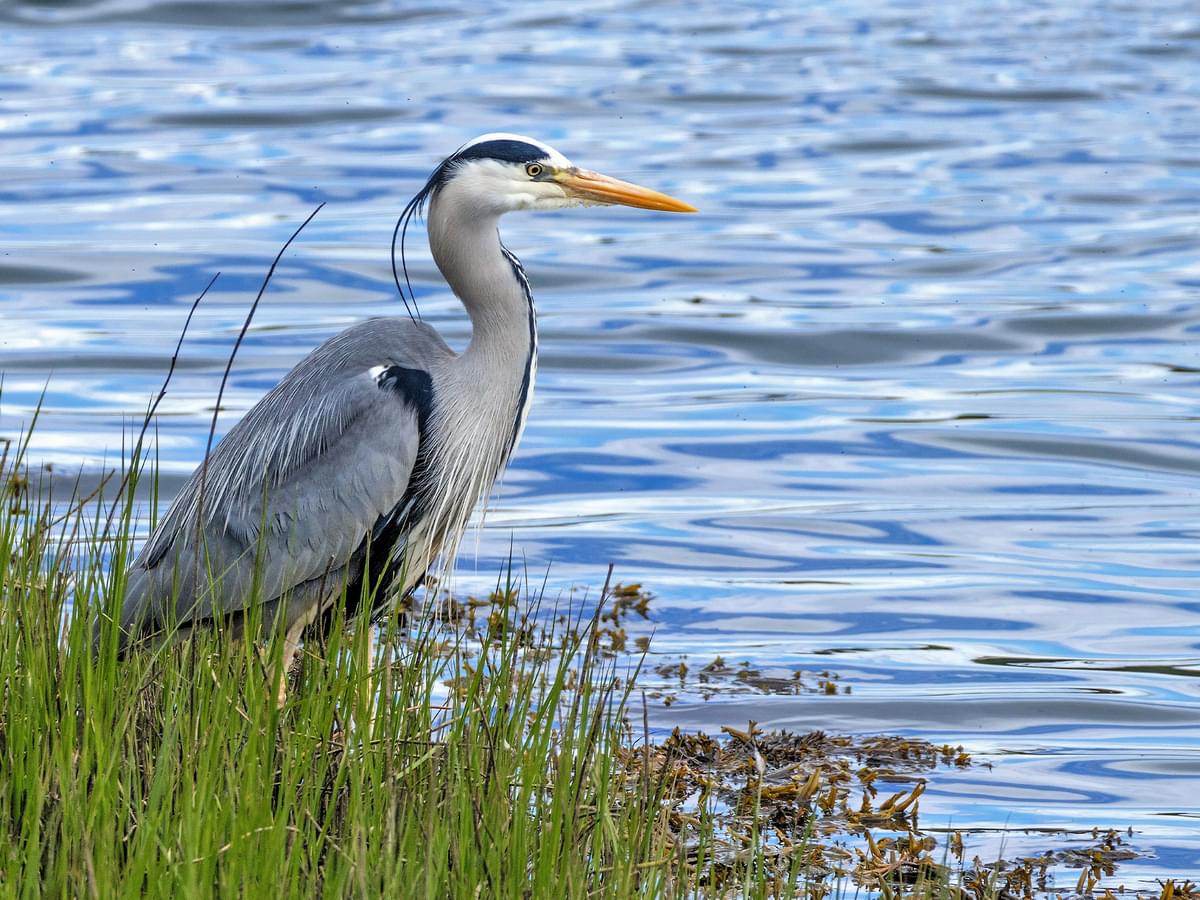
Length
90-98cm
Wingspan
175-195cm
Weight
1.02-2.073kg
Grey Heron
The Grey heron is easily the UK’s most common heron, with an estimated breeding population of around 13,000 nests. Migrants from northern Europe boost breeding numbers, and the UK's wintering population is estimated at 63,000 birds.
These powerful birds are tall, striking and intelligent. They’re patient hunters and can remain completely motionless for hours in waiting for their prey. Frogs, fish and other birds are no match for the Grey heron’s sharp bill, which it uses to skewer and impale prey before usually swallowing it whole. Grey herons are a menace to fish ponds and fisheries. Once they successfully hunt a fish in a pond, lake or fishery, you can be sure that they’ll be back for more until the stock is depleted!
Yes - Grey herons do eat other birds, especially the nestlings of other aquatic birds like moorhens, coots and ducks. However, this is relatively uncommon - the Grey heron certainly prefers fish.

Grey Heron eating a fish
Grey herons are quite sociable, and nest in large colonies called heronries. The RSPB reserve Northward Hill in Kent is home to 150 nests and is one of the best places to see the Grey heron in the UK. However, they’re common and can be found across most waterways in Wales, Scotland and Northern Ireland.
Appearance
Grey herons are large, tall birds that measure 90cm to 98cm long with a wingspan of 175cm to 195cm. They weigh 1.5kg to 2kg. The plumage is mostly grey on the wings with a white head and neck that has a distinctive spotted pattern along its underside. Grey herons have particularly long necks and legs. Their large wingspan is among the largest of any bird in the UK.
Little Egret
Egretta garzetta
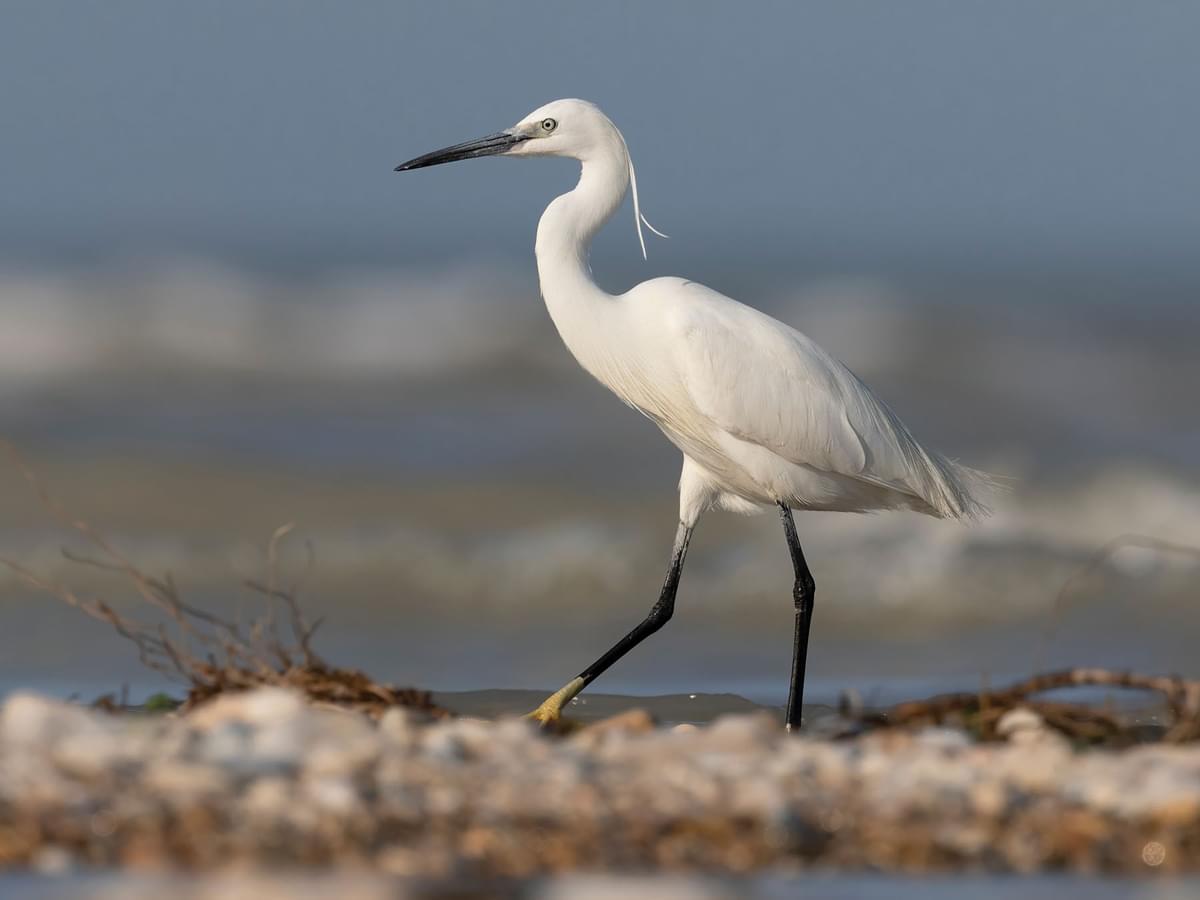
Length
55-65cm
Wingspan
88-106cm
Weight
350-550g
Little Egret
Little egrets started wintering on the French Mediterranean coast in the mid-19th-century, and would return northwards and westwards to breed across central and northern Europe.
Populations were first established in Normandy and Brittany before they started arriving on UK shores in around 1950. The Little egret’s small breeding colonies grew significantly by 1989 when around 100 birds arrived on the south coast. By 1996, two breeding colonies were confirmed in Brownsea Island, Dorset, and Cornwall.
There is evidence that the Little egret is a former breeder in the UK, however, as many medieval texts seem to refer to them as ‘egrittes’, specifically during the early 15th-century reign of Henry IV, Henry V and Henry VI. Little egrets were heavily persecuted for their brilliant white plumage, which once became more expensive than gold at £15 per oz, equivalent to £900 in today’s money!

Little egret (Egretta garzetta) flying over the reeds, Norfolk, UK
Little egrets are still uncommon in the UK, with an estimated 660 to 740 breeding pairs. However, breeding numbers are boosted by winter migrants, which increase the population to around 4,500 birds. You can find them in East Anglia, the estuaries of Devon and Cornwall, Poole Harbour and Chichester Harbour.
Appearance
Little egrets are reasonably large among other UK birds, measuring 55 to 65cm long with an 88 to 106 cm wingspan. They weigh around 350 to 550g. Their body is tall and very slender. Their brilliant white plumage is unmistakable and contrasts with their large eyes, yellow iris, orange bill and black-grey legs.
Eurasian Bittern
Botaurus stellaris
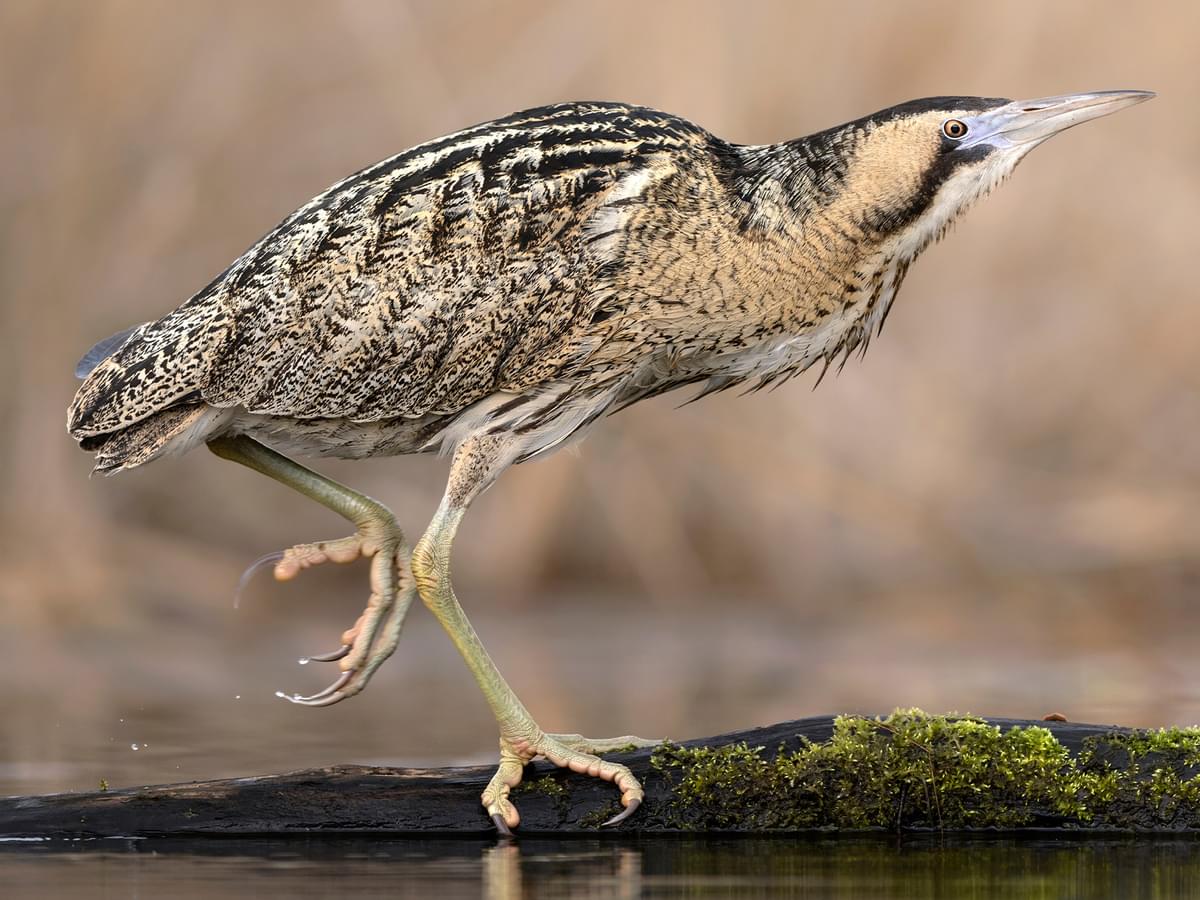
Length
69-81cm
Wingspan
100-130cm
Weight
900-1900g
Bittern
The Eurasian bittern is almost the opposite of the Egret; they’re small, compact, with a relatively thick neck and camouflaged brown plumage. The Eurasian bittern is the largest bittern and is found across much of central and eastern Europe and central and eastern Asia. The species usually migrate south to south Asia, Africa and the Indian Subcontinent.
The UK’s bittern population is tiny, with around 200 or so males recorded in 2020. However, this has increased from just 80 or fewer males in the 1950s. In 1997, the population reached a critical low point before conservation efforts boosted resident populations.
Bitterns rely on highly specific reedbed habitats that are dense and foliaged to keep them well-hidden. As a result, this secretive bird is tricky to spot. Bitterns are most active at dusk, night and dawn, and rarely appear during the day.

Bittern in flight
One of the most distinctive characteristics of the bittern is its super-loud booming foghorn-like call that can apparently be heard up to 3 miles away!
There are two reliable RSPB reserves for spotting bitterns; at Minsmere (Suffolk) and Leighton Moss (Lancashire). The Eurasian bittern’s UK conservation status is listed as Amber.
Like most other herons, bitterns hunt fish, amphibians and large aquatic insects.
Appearance
Bitterns are thick, strong herons that measure 69 to 81cm in length, with a wingspan of 100 to 130m. They weigh around 0.87 to 1.94kg. Like other herons, bitterns have long necks but are also particularly thick. The plumage is mostly dark and light-banded brown on the body and wings, lighter on the neck. The crown and nape are black.
Bitterns are well-camouflaged and prefer to stay hidden. They’re slow-moving birds that stalk through the undergrowth in pursuit of amphibians, fish and small reptiles.
Less common and rare Heron species in the UK
Most of these heron species below are rare visitors to the UK, but on occasions have been spotted.
American Bittern
Botaurus lentiginosus
Length:
58cm to 85cm
Wingspan:
92cm to 115cm
Weight:
370g to 1.072kg
American Bittern
The American bittern is a rare vagrant from North America. There have been fewer than 20 records of American bitterns in the UK.
One of their more notable appearances occurred in 2020 at Carlton Marshes, Suffolk, where an American bittern sighting sparked an influx of 2,000 birdwatchers who wanted to catch a glimpse of this rare visitor. That was the first sighting since 2010 - ten years before!
Appearance
The American bittern is similar to the Eurasian bittern but slightly smaller, stockier and more rounded. They measure 58 to 85cm long with a wingspan of 92 to 115 cm and weigh between 370 to 1,072g. In addition, they have a bold yellow-striped bill, which the Eurasian bittern lacks with the same level of contrast.
Little Bittern
Ixobrychus minutus
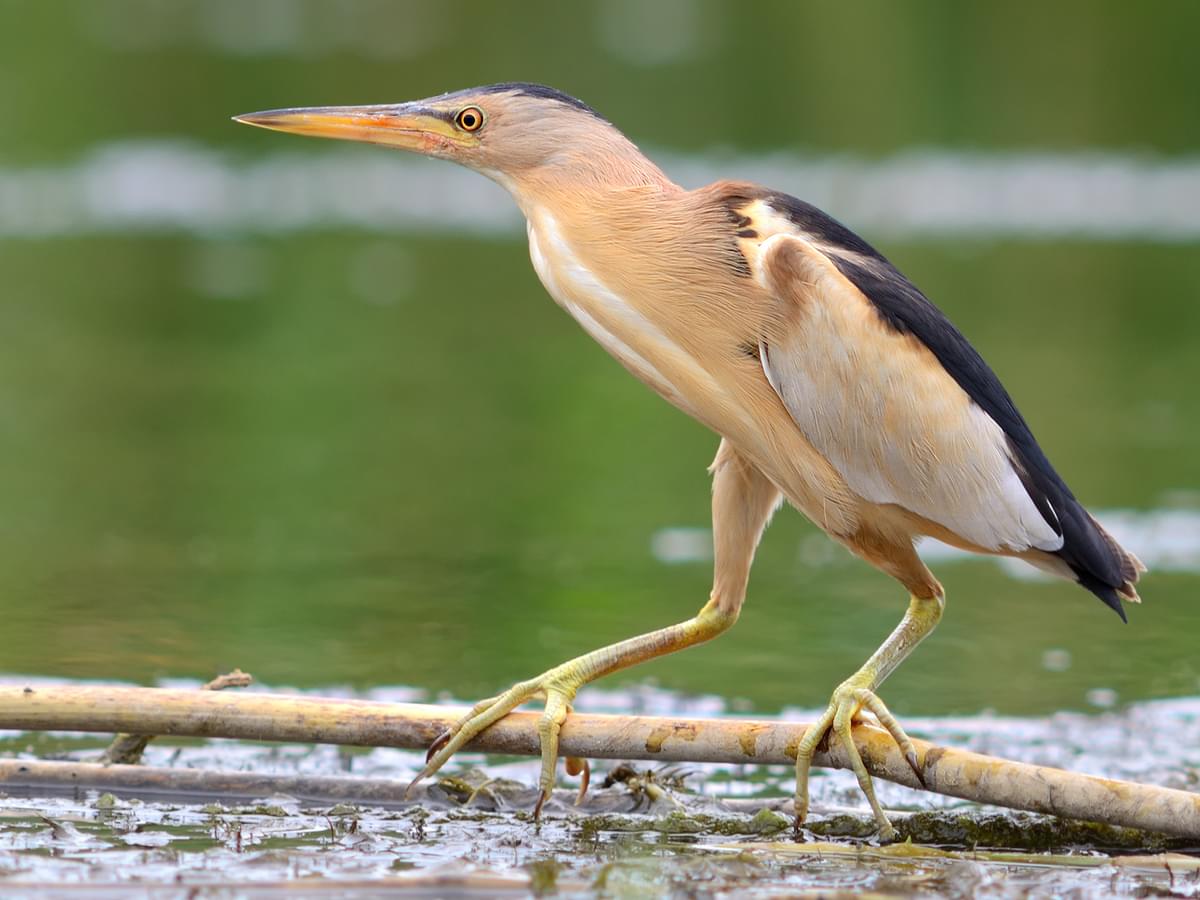
Length
33-38cm
Wingspan
49-58cm
Weight
59-150g
Little Bittern
The Little bittern was likely reasonably common in the UK but now breeds east of here in central, southern and eastern Europe and central Asia.
Breeding pairs of the Little bittern were suspected at South Walsham Broad in the mid-19th-century, but it wasn’t until 1984 when three young were raised in South Yorkshire.
In 2010, a pair of Little bitterns built a nest at Ham Wall reserve in Somerset. No reliable breeding sightings have been recorded since. There are around 271 recorded sightings of Little bitterns in the UK as of 2019.
Appearance
The smallest breeding heron in Europe, measuring 33 to 38cm long with a wingspan of 52 to 58cm. The Little bittern is paler than other bitterns but still features the same heron-like body and neck. It’s one of the smallest members of the heron family.
Green Heron
Butorides virescens
Length:
41cm to 46cm
Wingspan:
64cm to 68cm
Weight:
240g
Green Heron
A rare vagrant from North America, there are very few sightings of the Green heron in the UK. One of the most famous visits was recorded in 2010 at Pentewan, Cornwall yesterday, where it was sighted at the Lost Gardens of Heligan. A later sighting was made in 2018 at Llanmill, Pembrokeshire.
The Green heron is a beautiful, photogenic heron that breeds across the eastern US. This migratory species typically migrates to Central and South America, but some seem to find their way over the Atlantic.
Appearance
The Green heron lives up to its namesake with emerald-green wings and a chestnut breast. It’s a small heron, measuring 41 to 46cm long with a wingspan of 64 to 68cm.
Squacco Heron
Ardeola ralloides
Length:
44cm to 47cm
Wingspan:
80cm to 92cm
Weight:
230g to 370g
Squacco Heron
The Squacco heron of eastern and southern Europe, the Middle East, North Africa and south-central Asia is a very rare vagrant to the UK, where it’s been sighted some 271 times.
A recent sighting was made in 2012 at WWT Welney reserve at the border of Cambridgeshire and Norfolk.
Appearance
A small, light brown heron with an interesting blue bill and green face. Measures 44 to 47cm long with a wingspan of 80 to 92cm.
Cattle Egret
Bubulcus ibis
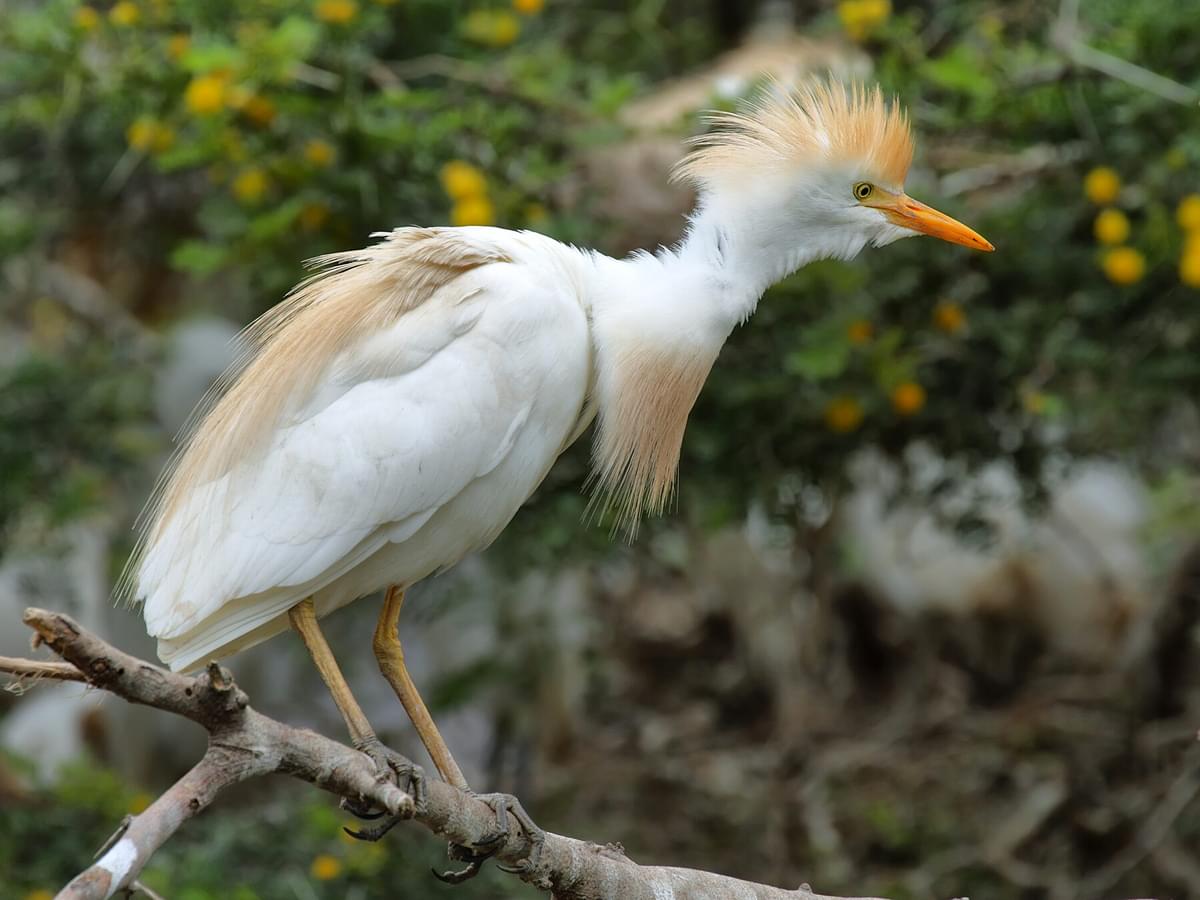
Length
46-56cm
Wingspan
88-96cm
Weight
270-512g
Cattle Egret
The Cattle egret is named as such because it lives near livestock and eats insects disturbed by the movement of cattle and other agricultural animals. This differs from the aquatic foraging behaviours of other herons.
Cattle egrets breed in the Americas, Europe, Asia, Africa and Australasia, which makes them one of the most widely distributed species of herons. However, their closest breeding populations to the UK are found in France, Spain and Portugal.
Small numbers of Cattle egrets have arrived in the UK, and they’ve started to breed across parts of south and central England, including Oxfordshire and Somerset. In 2007/2008, many Cattle egrets arrived in the UK, with the largest numbers in southwest England, though some ended up on the eastern Irish coast and parts of Scotland.
Appearance
A stocky heron with interesting orange head tufts in the breeding season. The Cattle egret is more hunched than most herons and measures46 to 56cm long with a wingspan of 88 to 96cm. They weigh 270 to 512g.
Snowy Egret
Egretta thula
Length:
56cm to 66cm
Wingspan:
100cm
Weight:
370g
Snowy Egret
Another rare North American vagrant. The British Ornithologists' Union Records Committee (BOURC) accepted a sighting at Balvicar, Argyll and Bute, Scotland, on 5 November 2001. This is the only accepted record of this bird in the UK.
Appearance
Very similar to the Little egret, though it has an all-black bill.
Great White Egret
Ardea alba
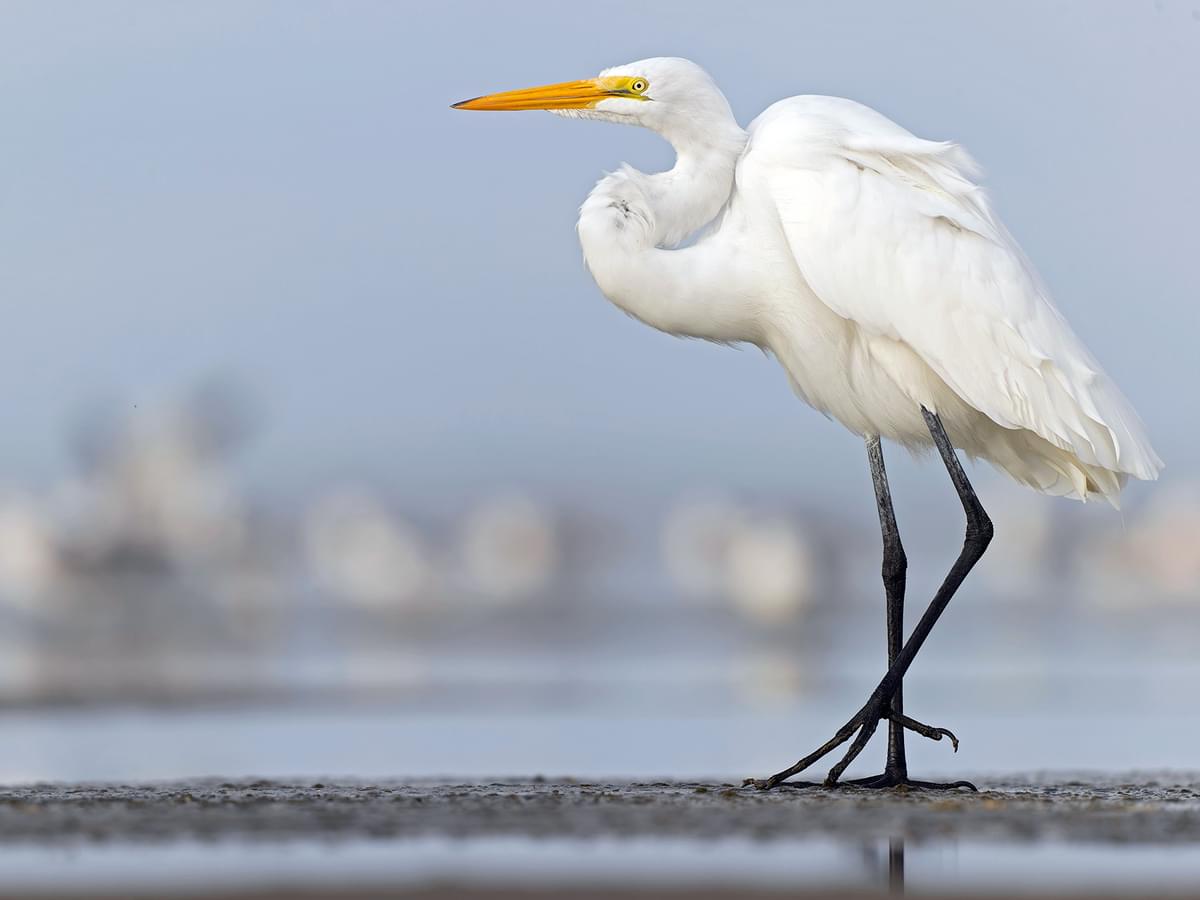
Length
80-104cm
Wingspan
131-170cm
Weight
700-1500g
Great White Egret
A large, elegant egret with an extra-long neck. These birds were rarely sighted before 2000, but in 2020, there were 8,000 reports, which hints at the possibility of reliable breeding populations.
The Somerset Levels homed a confirmed breeding pair of Great White egrets in 2012. These birds are found primarily across southeast England and East Anglia, but sightings have occurred pretty much everywhere.
Appearance
Essentially similar to the Little egret but larger with a much longer neck. The Great White egret is a similar size to the Grey heron, measuring up to 1m tall with a wingspan of 131 to 170cm.
Great Blue Heron
Ardea herodias
Length:
91cm to 137cm
Wingspan:
167cm to 201cm
Weight:
1.82kg to 3.6kg
Great Blue Heron
The North American Great Blue Heron was added to The British Ornithologists’ Union Records Committee (BOURC)’s Category A British List after a juvenile was sighted on 7th December 2007, on St Mary’s, Isles of Scilly. There are just two records in total.
Appearance
The largest heron in North America, standing at up to 137cm tall with a wingspan of over 2m. Largely grey-blue, but comes in different colour morphs.
Purple Heron
Ardea purpurea
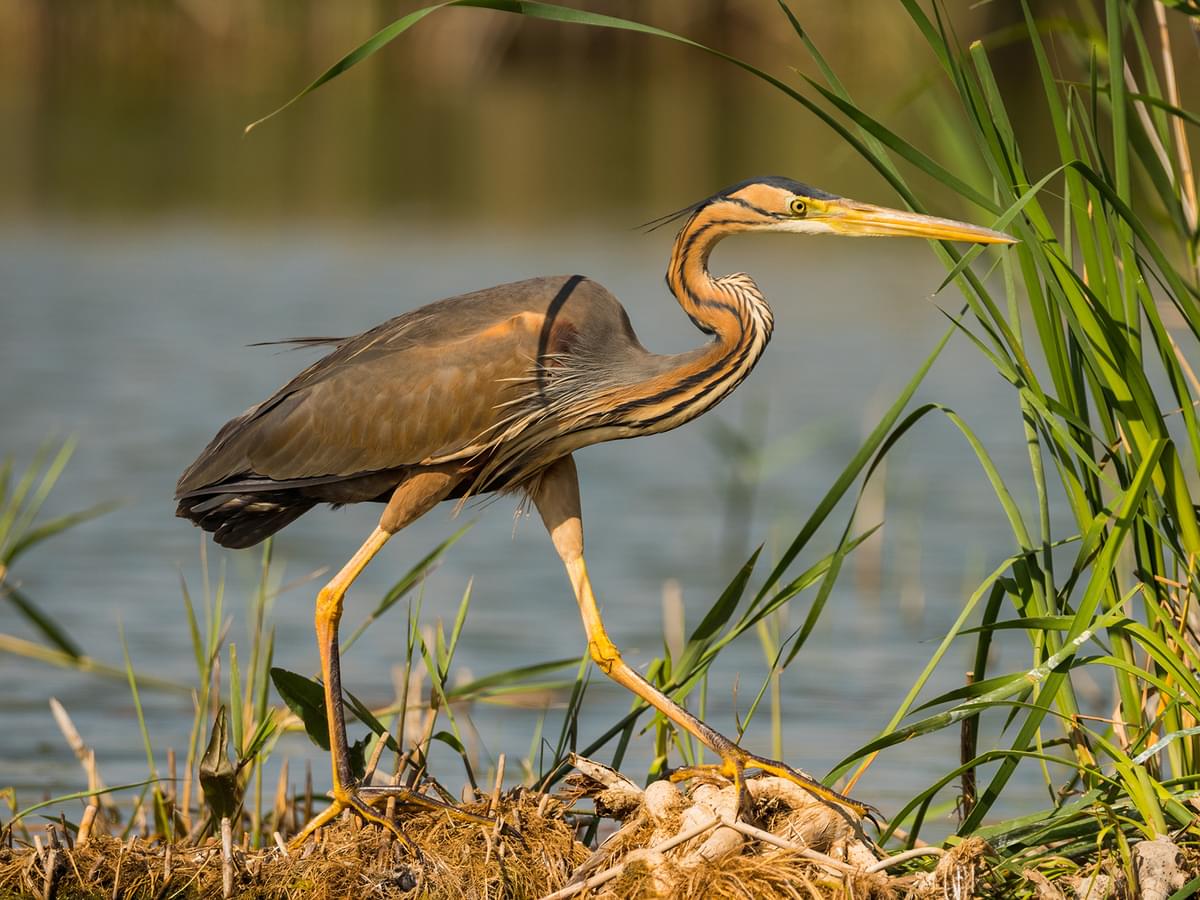
Length
78-90cm
Wingspan
120-150cm
Weight
500-1400g
Purple Heron
This vagrant from parts of southern Europe breeds across Africa, Asia and eastern Europe, extending all the way to Japan and is spotted around 20 times per year. One notable sighting occurred at Noah’s Lake on the Avalon Marshes, Somerset, in 2018.
Appearance
A large heron, largely not purple but a blue grey-blue with an interesting brown striped neck. Measures 78 to 97 cm long with a wingspan of 120 to 152cm.
What are herons?
Herons are long-legged aquatic and wading birds from the family Ardeidae. There are 64 recognised species distributed across much of the world. Herons are generally quite large, but range from the Dwarf bittern to the Goliath heron, which stands at around 1.5m tall.
Herons are intelligent hunters that are virtually carnivorous. Most consume insects, fish, amphibians, reptiles, mammals, and small birds, in the case of the largest herons.
Herons are predatory and have numerous hunting techniques. Some species even use bait to tempt fish towards them to make hunting easier.
The heron family also includes egrets and bitters, which are not considered a biologically distinct family.

Dwarf Bittern

Goliath Heron
Are herons rare in the UK?
The UK’s most common heron is the Grey heron, which is common throughout Europe, Asia and Africa. There are some 13,000 Grey heron nests in the UK. Breeding populations are supplemented by winter visitors.
The UK’s other two resident breeders, the Little egret and the Eurasian bittern, are both comparatively uncommon. Several other species of herons end up in the UK as vagrants from Europe and North America.
What is the most common heron in the UK?
The Grey heron is easily the UK’s most common heron, with some 13,000 nests and 63,000 birds during winter. On the other hand, the Little egret and bittern are comparatively rare, with under 1,000 breeding pairs.

The Grey heron is the most common and the largest heron species in the UK
What is the largest heron in the UK?
The UK’s most common heron, the Grey heron, is also its largest. Grey herons are 90cm to 98cm long with a wingspan of 175cm to 195cm. They weigh 1.5kg to 2kg.
What is the smallest heron in the UK?
The Little egret is the UK’s smallest heron, measuring 55 to 65cm long with an 88 to 106 cm wingspan. They weigh around 350 to 550g.

The Little Egret is the smallest heron species in the UK
How many types of herons are there in the UK?
There are three species of breeding herons in the UK; the Grey heron, Eurasian bittern and Little egret. In addition, there are seven rare visitors that end up in the UK as vagrants from Europe and North America, including the Little bittern, Squacco heron, Green heron, Cattle egret, Snowy egret, Great white egret and Great blue heron.
What herons are native to the UK?
The Grey heron, Bittern and Little egret are native to the UK. Little egrets were very uncommon in the 19th century, but medieval literature from the 14th and 15th centuries refers to them.

Bitterns are secretive birds, and often hide in reedbeds
Are herons protected in the UK?
All herons are protected under The Wildlife and Countryside Act 1981. The Eurasian bitter is currently on the UK’s Amber conservation list, while the Grey heron and Little egret are listed as Green.
Do herons have predators in the UK?
Grey herons, bitterns and Little egrets face threats from some land predators like foxes, but overall, herons are rarely predated by other animals, in the UK at least.
Are there herons in London?
Grey herons live in Regent’s Park, where a large heronry is established on what’s now called Heron Island. You can also spot herons at Battersea Park, Walthamstow Wetlands, and by the Thames in Richmond and Kingston.
